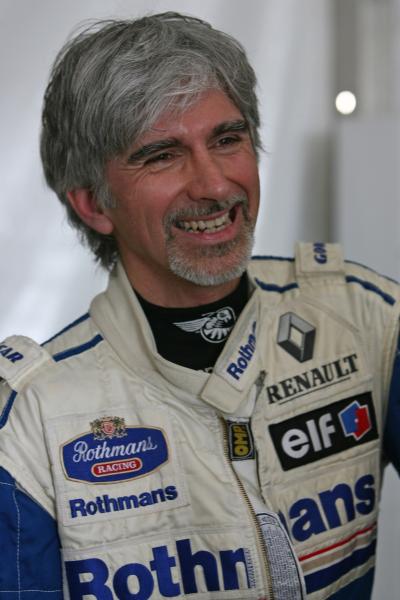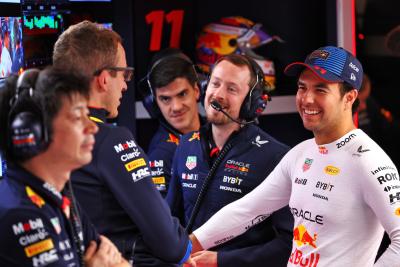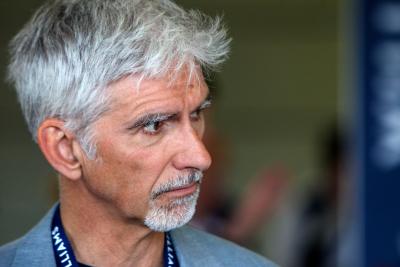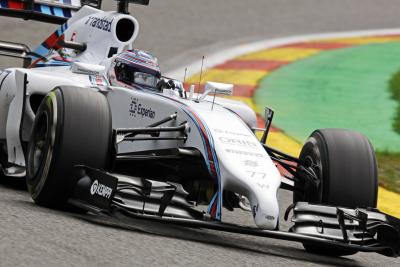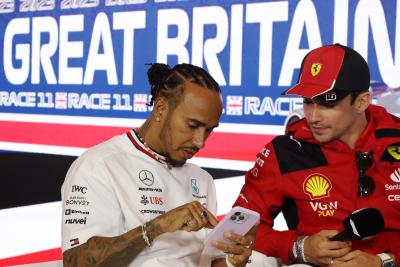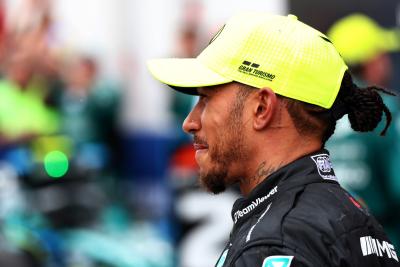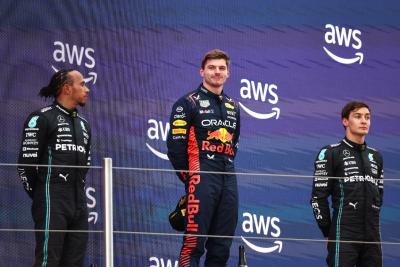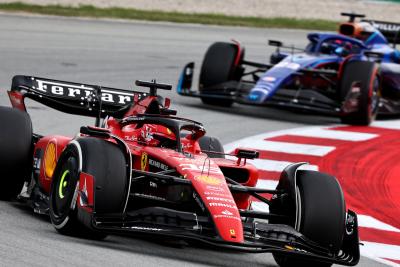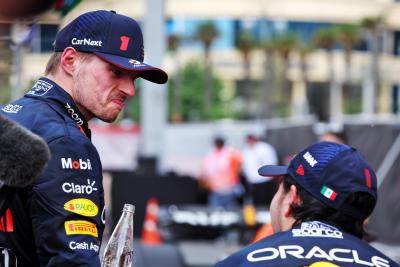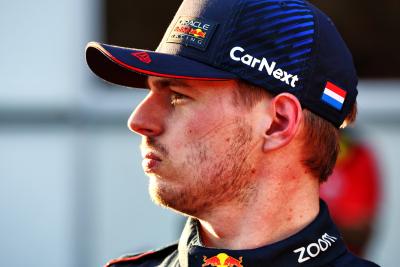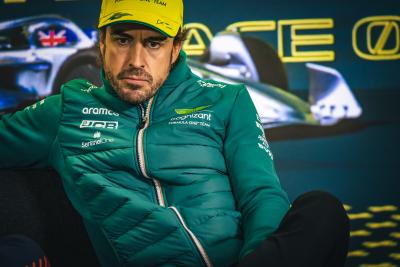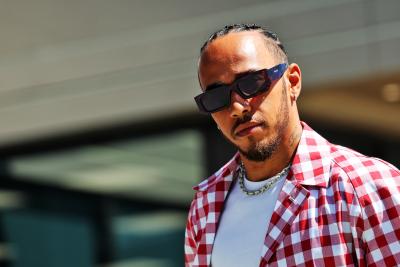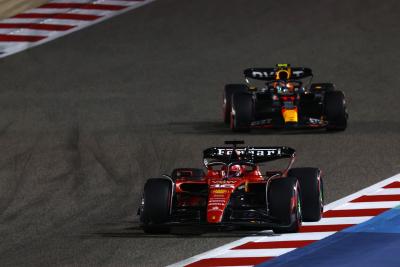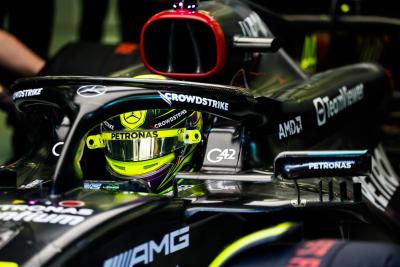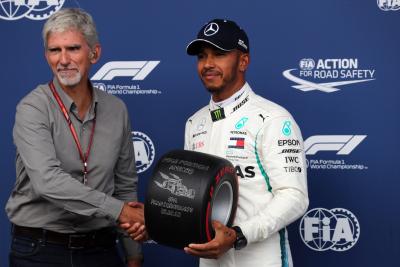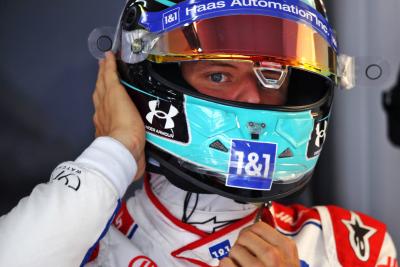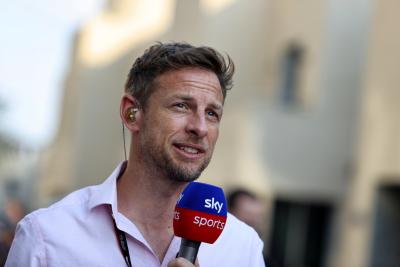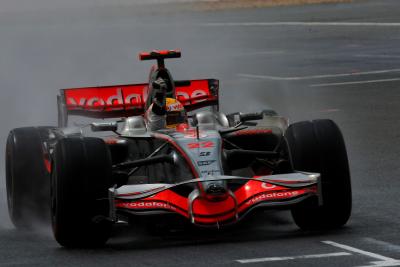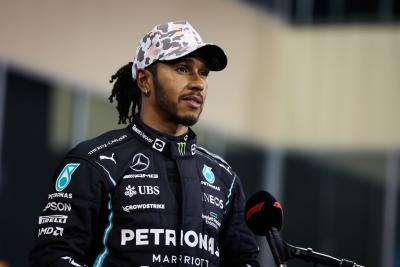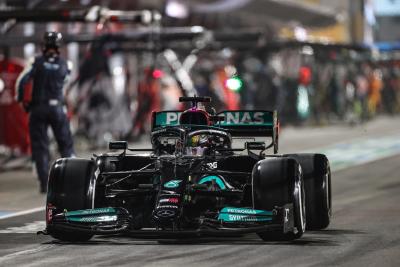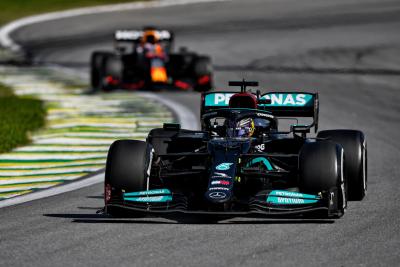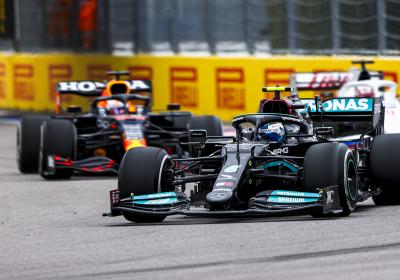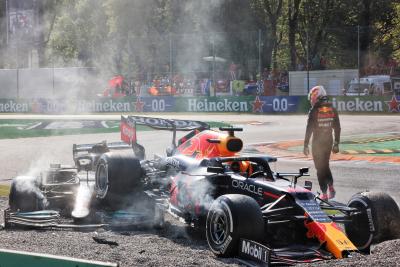Damon Hill
Personal Information

About Damon Hill
Damon Hill F1 Career Overview
The first (and one of only two) drivers to emulate their father in winning the F1 World Championship, the F1 career of 1996 champion Damon HIll may have been fairly short but it nonetheless left a lasting legacy.
Career Stats
Latest News
Full Biography
Damon Hill F1 Career Overview
The first (and one of only two) drivers to emulate their father in winning the F1 World Championship, the F1 career of 1996 champion Damon HIll may have been fairly short but it nonetheless left a lasting legacy.
A driver not quite touted for greatness on the strength of the results in his junior career, while HIll’s route to the top was arguably massaged by being the son of the late Graham Hill - champion in 1962 and 1968 - it was Hill’s ability to grasp an unexpected opportunity at Williams that propelled him to greatness.
Making his F1 debut with the dwindling Brabham team in 1992 - where he qualified for only two of the eight races he was entered before the team folded - Hill was nonetheless surprisingly selected with Alain Prost by Williams to replace outgoing champion Nigel Mansell and Ricciardo Patrese in its cars for 1992.
Despite the huge promotion, Hill performed strongly in the competitive machine, setting up the opportunity for him to challenge for the 1994 and 1995 titles. After being beaten by Michael Schumacher on both occasions (most gallingly in controversial circumstances in 1994), Hill went one better in 1996 to claim the crown.
Nonetheless, after contract negotiations between Williams and Hill broke down in the wake of his title win, Hill made the shock move to Arrows for 1997 - despite it being a backmarker in 1996 - and suffered the consequences with a tough year, even if he did come painstakingly close to a remarkable win in Hungary.
Hill nonetheless found some revival with a switch to Jordan in 1998 and 1999 - which included a famous victory in the Belgian Grand Prix - before quitting at the end of the season and walking away from full-time competition.
Damon HIll F1 Career - Team-by-Team
Brabham: 1992
Though he was only 15-years old when his two-time World Championship winning father Graham died in a plane crash, Damon Hill developed his racing craft in the years that followed, first in motorbikes and then in the International F3000 Championship.
While his results weren’t noteworthy (two podiums across four seasons), Hill landed an F1 drive for the 1992 season at the relatively senior age of 32 with Brabham. Making his debut from Round 4 in Spain in place of Giovanna Amati - the last woman to start an F1 race - Brabham, though storied, was a shadow of its past successes and the Judd-powered car struggled to qualify for one of the 26 spots available from 32 entries.
Failing to qualify in five successive races, Hill eventually (by a tenth) made the grid for the first time on home soil at SIlverstone, a feat he repeated one more time in the next two races before the ailing team folded ahead of the Belgian Grand Prix.
Williams: 1993-1996
While his brief and unspectacular Brabham stint had given him no opportunity to demonstrate any potential, the team’s collapse did afford Hill time to explore other options and was duly taken back under Frank Williams’ wing after a test outing in 1991.
Even so, it was still a shock to the paddock when Williams announced Hill would join the championship-winning team alongside Alain Prost for 1992, given how minor his profile was measured against a team that had dominated the previous year with Nigel Mansell.
Though seen as a huge - perhaps unnecessary - risk, Williams expected it would hold onto likely title contender Prost for only a single year and wanted to hone British talent in a second seat less reliant on delivering results.
As it happens, Hill quickly adapted to what was still the car to beat and was on the podium in only his second race at Interlagos, following it up with similar results at Donington Park, Monaco, Montreal and Magny-Cours before scoring a superb victory in Round 11 at the Hungaroring, winning by more than a minute.
That success led to more wins at Spa and Monza elevating his championship position before concluding the year with podiums in Portugal and Australia to clinch third overall at the end of his first full season.
With Prost, as expected, retiring on winning his third and final crown, he was replaced by Ayrton Senna with Hill once again expected to play a supporting role to the high-profile Brazilian. However, Senna’s death during Round 3 at Imola elevated Hill to a team leader role, pressure heightened by the fact Williams’ superiority from 1992 and 1993 was being tested by Benetton and Schumacher.
Initially Schumacher marched ahead but two exclusions and a two race ban for the German - coupled with a run of three victories for Hill during the second-half of the year - meant the pair were split by just a single point in the Benetton driver’s favour heading to the Adelaide finale.
The fierce tussle came down to a critical moment on lap 36 of 81 when Schumacher, under pressure from Hill, ran wide at the East Terrace corner and clouted the wall. With the Benetton - most likely damaged in the impact - losing momentum, Hill sensed his opportunity and nosed up the inside at the following right-hander, only for Schumacher to come across him to make contact.
Schumacher was flicked onto two wheels and into the barriers, putting him out of the race, but the Williams had also sustained damage and Hill was forced to park up. Two DNFs meant Schumacher was champion, but the incident was widely viewed as being a deliberate attempt by Schumacher - knowing his car would have been forced to retire anyway - to neutralise his opponent by ensuring he didn’t score either.
The FIA didn’t take the same view, however, and despite most siding with Hill. with only extreme result-affecting penalty options (such as an unprecedented deduction of overall points) available to it given neither car made the finish, deemed it a racing accident to confirm Schumacher as World Champion.
Putting the bitter end to 1994 behind him, Hill came back strongly in 1995 and once again went head-to-head with Schumacher for the title. However, with both the Williams and Benetton sporting identical engines, the latter proved the more reliable chassis and the German stayed out front for much of the year to win by a comfortable 33 points.=
With Schumacher defecting to Ferrari - which was unlikely to be in a position to fight for the title just yet - Hill was the hot favourite to finally clinch the F1 title in 1996, but faced up to a fresh foe in rookie team-mate Jacques Villeneuve, who kept the Briton honest from the word go.
However, Hill’s greater experience shone through in a Williams back to its best, winning four of the opening five races to set himself on course. Four more wins followed and though a lean spell during the closing stages allowed the in-form Villeneuve to keep the title fight alive to the Suzuka finale, Hill needed only a single point to confirm the inevitable, which he did with an eighth win of the year.
Hill’s success, however, didn’t prevent him from running into problems with team owner Frank Williams and before the end of the year the two parties confirmed a sensational split ahead of him being crowned World Champion.
Indeed, Hill felt he should have been rewarded with a more lucrative contract for his title win but Williams was reportedly steadfast in cooling his effect on the team’s success, arguing his success was primarily the result of being provided with a superior car compared with its rivals and pointed to a ‘lack of aggression’ against a driver like Schumacher for why he didn’t deserve a similarly well-paid role.
Hill baulked against this attitude and sought alternative arrangements for 1997, though even then found it difficult to source a drive with McLaren and Benetton having already signed its drivers.
After interest from Jordan, Hill stunned the paddock by confirming he would be taking his No.1 plate to Arrows despite the team scoring just a single point in 1996.
Arrows: 1997
While it was difficult to see the wisdom in reigning champion Hill switching from Williams to Arrows - a team that hadn’t won a single F1 race and had been mired in the mid-to-tail end during the most recent years - there were some logical key factors in the decision.
Mid-way through the 1996 season, Tom Walkinshaw and his well-respected TWR (Tom Walkinshaw Racing) outfit had taken Arrows over from Footwork (thus returning it to its original name). It meant Arrows was able to meet Hill’s salary demands - thought to be in the region of $7.5m - and the team was moved into a brand-new facility in Leafield.
Moreover, TWR had high hopes the arrival of Hill would bring with its the gravitas of greater sponsorship and more potent partners, and for a time it was anticipated the team would land a competitive engine package from Mugen-Honda. He’d also taken a punt on incoming tyre suppliers Bridgestone in the hope it would prove advantageous over the more universally adopted Goodyear, even if the Japanese firm had failed to drum up much interest from teams and instead started 1997 supplying only Arrows, Prost, Minardi, Stewart and the short lived Lola team.
However, when Prost instead landed the Mugen-Honda deal (which indeed proved very competitive) and back-up option Peugeot stuck with Jordan, the Arrows project began to go awry when it selected Yamaha as its engine partner instead.
Yamaha - better known for its exploits on two wheels - had endured only patchy success in F1 up to this stage, supplying Zakspeed, Brabham, Jordan and latterly Tyrrell, picking up only a single podium result back in 1994.
Tuned by Judd, the engine lacked the performance of its rivals and was hamstrung by woeful reliability, which spoiled what was otherwise a solid chassis. Qualifying second to last on his debut with the team signalled a bad omen and Hill spent the first half of the season running towards the back of the field in a shadow of the previous year’s highlights.
Even so, form did begin to pick up mid-season, spurred on by a popular sixth place at Silverstone which yielded his and the team’s first point of the year.
However, things could have ended up very differently had an inspired Hill been able round out what looked like being a shock victory in the Hungarian Grand Prix. Assisted by the Hungaroring’s tight and twisty nature, which negated the Yamaha engine’s lack of pace, Hill placed the car a shock third on the grid behind his old foes Schumacher and Villeneuve.
Running second early on, Hill remarkably grabbed the lead from Schumacher on lap 11 and quickly scampered into a lead that swelled to 35secs, helped by the fact the Bridgestone tyres - though flawed - worked particularly well in hot temperatures, a fact that had been helping Prost to eye-catching results all year.
With Arrows sensing its first win - after 20 years of trying - heartbreak was to descend on the plucky team as the car began to slow with only three laps remaining, the result of a broken throttle linkage that was causing the engine to cut out.
Villeneueve swiftly caught Hill and passed on the final lap, leaving the distraught team to wonder what could have been despite second place still being an extraordinary result that far surpassed anything it had achieved in more than a decade.
Nonetheless, it would prove to be a quirky result even if Hill was certainly more competitive by the end of the year, form that enabled him jump ship to Jordan for 1998.
Jordan: 1998-1999
Having lost out in the race to sign Hill following his Williams split, Jordan eventually got its man on a two-year deal for what would be the Briton’s final campaigns in F1.
With Jordan swapping its Peugeot engines out for Mugen-Honda power, Hill came into the year with stiff internal opposition from a familiar name in Schumacher, this time Ralf, Michael’s brother.
The Jordan 198 wasn’t competitive from the off though and it took Hill until Round 11 in Germany to get on the board with a run to fourth, a result he matched next time out in Hungary.
However, Hill’s fortunes took a huge upturn at the next race in a chaotic Belgian Grand Prix where his experience shone through the gloom of treacherous conditions at Spa-Francorchamps.
Surviving a first lap pile-up that eliminated four cars and another skirmish at the restart that took three more out of the running, Hill kept his nose clean as more drivers fell by the wayside in the tricky conditions to find himself in the running for the podium behind the Michael Schumacher.
This became the lead when Schumacher famously clouted the back of David Coulthard’s McLaren and with Jordan - yet to win a grand prix - ordering close-following team-mate Ralf Schumacher not to attack or jeopardise a historic 1-2 for the Irish outfit, Hill held on to secure his 22nd and final F1 win.
Staying on board for 1999 but intimating it would be his last, while team-mate Heinz-Harald Frentzen multiplied Jordan’s victory tally with three victories, it was clear Hill was winding down his career. Resisting the urge to walk away in the middle of a modest season that peaked with a fourth in Imola, Hill somewhat pointedly retired from his final race - and F1 - citing ‘mental fatigue’.
Damon Hill - Beyond F1
With his F1 career beginning relatively late at 32, Hill didn’t seek alternative racing plans when he retired aged 39, but has remained closely involved from the sidelines, notably becoming President of the British Racing Drivers’ Club in 2006.
He is now a regular contributor to Sky Sports F1’s TV coverage as a pundit and dabbled in a music career having regularly made appearances at the British Grand Prix stage show as a guitarist.
Ironically, Hill was one of the stewards responsible for handing down a five-place grid penalty to Michael Schumacher for overtaking under yellow flags during qualifying for the 2010 Monaco Grand Prix, thus denying the German the chance to start the race from what would have been his final F1 pole position.
